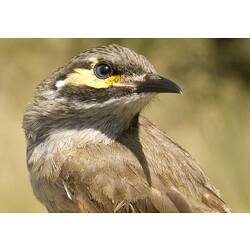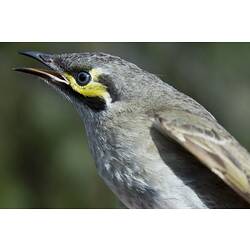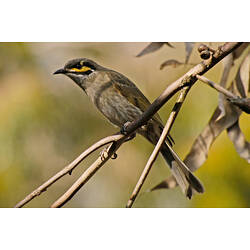General Description
A small to medium-sized honeyeater. Upper body green-brown with paler underparts. Distinctive wide yellow stripe surrounded by black on face. Some brown streaking on head. Bill curves down slightly. Bill to tail length up to 18 cm. Call a repeated "chick-up".
Biology
Yellow-faced Honeyeaters are often found near water or wetlands. They are part-migratory; in autumn, high country populations move down to lower areas, while many other populations move north, returning south at the end of the summer. They migrate in large flocks. Yellow-faced Honeyeaters feed on nectar, pollen, fruit, seeds and invertebrates. They feed in small groups in amongst tree foliage and also catch insects while flying. Females build a delicate, cup-shaped nest woven from moss or lichen in understorey plants. Females incubate two eggs, but both parents defend their breeding territory and feed the chicks. Nests are commonly parasitised by cuckoo species.
Distribution
Eastern and south-eastern mainland Australia.
Habitat
Open forest and woodlands and urban areas.
More Information
-
Animal Type
-
Animal SubType
-
Brief Id
A light brown honeyeater with a prominent yellow face with black streaks.
-
Colours
Green, Brown
-
Maximum Size
18 cm
-
Habitats
-
Diet
Omnivore
-
Diet Categories
Nectar, Fruit, Seeds, Insects
-
Endemicity
-
Commercial
No
-
Conservation Statuses
CITES: Not listed, FFG Threatened List: Not listed, EPBC Act 1999: Not listed, IUCN Red List: Least Concern
-
Taxon Name
-
Common Name
Yellow-faced Honeyeater
-
Kingdom
-
Phylum
-
Subphylum
-
Class
-
Order
-
Family
-
Genus
-
Species Name
chrysops







